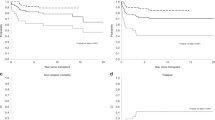Abstract
This retrospective study was undertaken to evaluate cure rates, toxicity and late effects of early intensive therapy followed by autologous stem cell transplantation (ASCT) in patients with advanced Hodgkin’s disease (HD). One hundred and fifty-eight cases of ASCT registered in the French database (SFGM) were retrospectively analyzed. Disease status at the time of ASCT was first partial response (PR) in 85, first complete remission (CR1) in 45 or primary refractory in 28 cases. The median time interval between diagnosis and ASCT was 7 months (range 4–13). At the time of analysis in December 1995, 121/158 patients (76.6%) were alive, including 111 (70.2%) in continuous CR with a median follow-up for surviving patients of 46 months (range 8–123). Peri-ASCT toxic death rate was 3%, and the actuarial risk of new malignancies was 4.9% at 5 years. The cumulative probability of 5-year overall survival (OS) was 75.2% for the entire group of patients, 80.6% for the chemosensitive ones, and 33.9% for the primary refractory (chemosensitive vs refractory, P < 0.0001). the cumulative probability of 5-year event-free survival (efs) was 66.1% for the entire group of patients, 73.7% for the chemosensitive ones, and 26.1% for the primary refractory (chemosensitive vs refractory, P < 0.0001). the only significant prognostic factor for both os and efs was disease status at the time of asct. early asct in advanced hd is feasible, with a low risk of toxicity and without a higher rate of late effects compared with conventional treatment. results achieved in chemosensitive patients at the time of transplantation lay the basis of future prospective randomized trials comparing acst as front-line treatment to conventional treatment in high-risk cases.
This is a preview of subscription content, access via your institution
Access options
Subscribe to this journal
Receive 12 print issues and online access
$259.00 per year
only $21.58 per issue
Buy this article
- Purchase on Springer Link
- Instant access to full article PDF
Prices may be subject to local taxes which are calculated during checkout
Similar content being viewed by others
Author information
Authors and Affiliations
Rights and permissions
About this article
Cite this article
Moreau, P., Fleury, J., Brice, P. et al. Early intensive therapy with autologous stem cell transplantation in advanced Hodgkin’s disease: retrospective analysis of 158 cases from the French registry. Bone Marrow Transplant 21, 787–793 (1998). https://doi.org/10.1038/sj.bmt.1701174
Received:
Accepted:
Published:
Issue Date:
DOI: https://doi.org/10.1038/sj.bmt.1701174
Keywords
This article is cited by
-
Autologous stem cell transplantation for Hodgkin's disease: busulfan, melphalan and thiotepa compared to a radiation-based regimen
Bone Marrow Transplantation (2003)
-
Upfront transplantation for poor-risk aggressive non-hodgkin lymphoma and hodgkin’s disease: Who benefits?
Current Oncology Reports (2001)
-
Autologous stem cell transplantation for advanced Hodgkin's disease in children
Bone Marrow Transplantation (2000)



